Homeland guinea fowl is considered to be Africa. In the period of antiquity, guinea fowls were bred in ancient Rome and ancient Greece. In the 15th and 16th centuries, Portuguese travelers once again brought these birds to European countries, after which they could be seen in many bird yards.
In Russia, guinea fowls appeared in the XVIII century, at first they were grown as an ornamental species, and only in the 2nd half of the XIX century the famous domestic poultry farmer Abozin I.I. described the guinea fowl in his book as an agricultural bird and was told about its cultivation methods.
Table of contents
What do the birds look like
Domestic guinea fowls are attributed to a number of chicken-like families of the fowl, it is related to turkeys, chickens and quails. Birds hatch for meat, eggs, feathersused for jewelry and fluff. From other farm birds, the guinea fowl is distinguished by its decorative and dense plumage.
The trunk of guinea fowls of medium length, rounded. The back is convex, wide, slightly lower at the back. High-level flat chests, females are fleshy, and males are pointed.
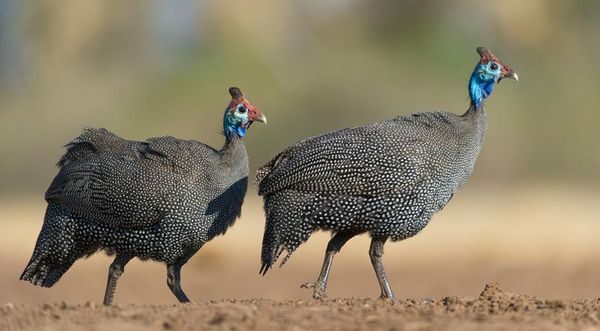
Stomach in guinea fowls taut. Wide and short head. Horny brown education on the head, resembling a helmet, has a triangular shape with a curved tip. The head is bald, covered with white and blue skin. The earrings are red outside, and the inside is white, diamond-shaped or rounded.
The retracted, slender neck rises high, on the upper part of the feathers there is little, the skin is bluish in color, on the lower part of the neck there is a gentle plumage, and on the back of it there are protruding thyroid-like feathers.
The bill is curved, massive and strong, orange-red in color with a gray bloom. Lower thighs protrude slightly. The eyes are large, shiny, dark brown. The wings are long and wide, tightly attached to the body. Saggy small tail, includes 16 feathers. The color of the skin depends on the breed of guinea fowl. and can range from light gray to bluish black.
These birds have a restless and fearful temperament. Guinea fowls are very accustomed to one person, and if a stranger enters them, the guinea fowl immediately raise a scream, therefore, in order to avoid noise, it is desirable for one person or permanent staff to look after them.
But, despite their increased excitability and ability to distinguish strangers from theirs, guinea fowls get along well with other agricultural birds and can be kept with them in the same pen.
Keeping and growing at home
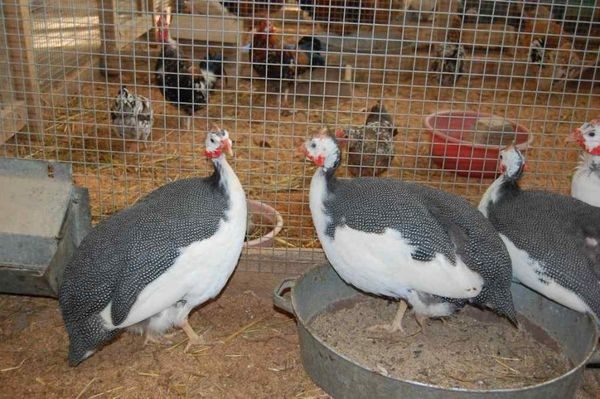
Guinea fowls are not picky birds at all, as it seems at first glance.This agricultural bird is bred in industrial conditions and in personal plots. Growing guinea fowl in industry is practically waste-free production, since these birds value not only meat and eggs, but also feathers.
For breeding guinea fowers used cellular, walking or outdoor year-round content in the premises. Poultry houses for guinea fowls are made a little more than for chickens, since this bird is freedom-loving and does not grow in small rooms.
Where to begin
Now many breeders grow guinea fowls in private farms. Cultivation and care of birds does not demand big expenses and a lot of time. Even a beginner farmer can handle it. For the maintenance of guinea fishes suitable sheds, adapted for poultry houses or specially erected buildings. Start breeding better with the arrangement of the room.
The floors in the room are made thorough, there should be no holes in them, so that the rodents could not penetrate inside and harm the bird. The coating is built of concrete, on which sawdust, fine straw or shavings are poured on top.
The litter should always be dry and change as it gets dirty.Dampness in the house can cause the development of diseases in birds. At a height of 8-10 cm from the ground is Laz. Guinea fowls, like chickens, need a roost.
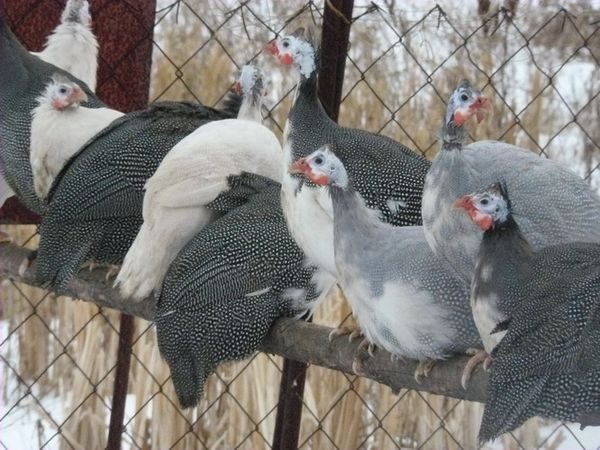
The distance between parallel bars of the perch should be 36 cm, the bar’s section should be taken at the rate of 4x2 cm. The bar located at the bottom should be installed 40 cm high from the floor level, and the height of the bar at the top should be 60-65 cm. birds: 1 meter - 6 guinea fowls.
Guinea fowls are herd birds, therefore they are kept by families, there are 4 females per 1 male. Guinea fowls react very strongly to lighting.
What conditions contain
Light mode for large birds: 27 weeks - 8 hours, 28-43 weeks - 16 hours, 44-50 weeks - 17 hours, from 51 weeks - 18 hours. Opening windows are made in the poultry house, onto which the grid is attached so that the bird does not fly away . The house should be regularly ventilated.
Under insufficient light, the growth of guinea fowl slows down.that economically negatively develops on the profitability of production.
During the day, guinea fowls are kept on the runs, and at night they are transferred to a shed. Since the bird can fly, it is better to cover the roof of the cages with a net. There should be no trees on the runs so that the bird cannot sleep on the branches, as this will lead to their wildness.
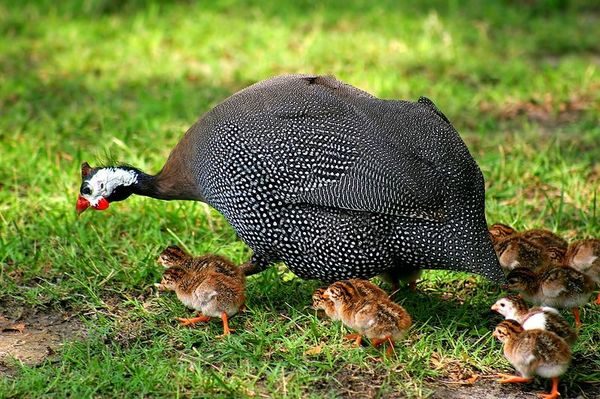
Ranges should be large and spacious, guinea fowls are birds very loving will. The presence of grass in the enclosures will only benefit the birds. Guinea fowl loves to eat beetles, worms and even ticks.
Comfortable temperature in the house is 14-18 ° С. Guinea fowls endure great frosts and when they are kept in winter, the house is heated only with very strong and prolonged cold. During the winter period it is required to monitor the ventilation of the premises.
Characteristics and weight
Males of guinea fowls have a live weight of 1.5-1.6 kg, and females - 1.6-1.7 kg. At about 8–8.5 months, puberty begins. Egg production seasonally, lasts 6-8 months.
From 1 bird get up to 120 eggs weighing 45-46 g. The hatchability reaches 90%. The safety of the young 95-99%. Duration of incubation 28 days. The eggs are light brown in color, round in shape and with a thick shell.
The shell structure is so dense that eggs can be stored at a temperature of from 0 to 10 ° C for half a year without losing their nutritional, taste and quality indicators.
View other features and benefits of this breed:
Per 1 kg increase is 3-3.4 kg of feed. On the day the guinea fowl consumes 150-200 g of feed. In 70 days, the chicks weigh 800-850 g. By 3 months the bird gains a bottomhole mass of 1.1-1.3 kg. By 5 months, the growth rate decreases as the maximum live weight of 1.7-2 kg is reached.
Slaughter yield is 82−85%. Guinea fowl is drier and, unlike chicken carcasses, it has 15% more muscle tissue.
Guinea fowl varieties
In the world there are more than 20 breeds of guinea fowls, differing in appearance and productivity. The most common and adapted to our climatic conditions are such gray-speckled, white-breasted Zagorsk, Siberian white, cream or suede, blue, white Volga, blue lilac, white and yellow.
- Gray speckled breed, it was previously the most popular, and has now lost its weight, due to the development of new, more productive species. The plumage is gray, covered with white round spots, the legs are also gray.
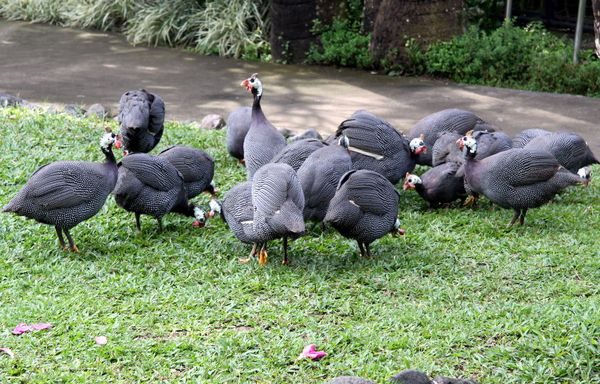
The most popular gray speckled breed Females of gray-speckled breed weigh 1.7 kg, and males 1.6 kg.Sexual maturity comes in 8 months. The average number of eggs from 1 layer is 90 pieces.
- Zagorsk white-breasted breed acquired its name due to the peculiar color of the plumage. The back and wings of the bird are gray-speckled in color, and the stomach, chest and neck are pure white. The male reaches 2 kg, and the female 2.5 kg. Sexual maturity comes in 7.5 months. Egg production is 115-116 eggs.
- Siberian white guinea fowl cream-white color with snow-white round spots throughout the plumage. The carcass of these birds is white and pink. Males weigh 1.6-1.8 kg, and females 1.9-2 kg. The average egg production per year is 100-110 eggs. Birds of this breed grow faster, have a calmer disposition and are much tougher than other species.
- Cream or suede guinea fowl has a bright plumage with white spots. The breed by plumage is similar to the Siberian white guinea fowl, only it is smaller in size, and the carcasses have a dark color. A characteristic feature of this breed is fast adaptation to any climate. The mass of males is 1.6 kg, and females 1.7 kg. Physiological maturity occurs at 8 months.
- Blue Guinea Fowl rarely found in farms. The main color is gray-blue with white spots, and the neck and part of the chest is purple.The male weighs 1.5-2 kg, and the female 2-2.5 kg. Egg production 120-150 eggs. Eggs are covered with small dots, which sometimes overlap.
- Volzhskaya white Guinea fowl has spread widely in the Republic of Mari El. Plumage and carcass white. The live weight of males is 1.6 kg, females 1.7 kg. Egg production: 85-90 eggs.
Breeding, feeding and care
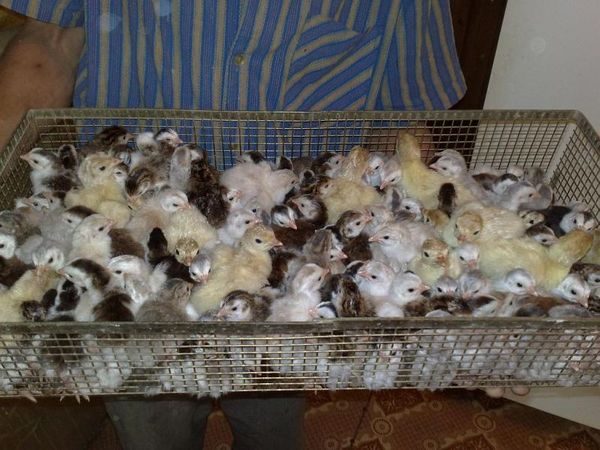
Guinea fowls receive food 3 times a day. In the morning they feed an ordinary wet feed mixture or dry feed, and in the afternoon and in the evening a grain or dry grain mixture. Barley and wheat are best fed in germinated form. Before the start of lay, feeding of the parent flock is enhanced.
Guinea fowl many green fodder requiredtherefore, grass, silage or grass meal should be included in the diet. With a walking-down content, an adult guinea fowl per year consumes: 32-36 kg of grain, 12 kg of green mass, 4 kg of root crops, 3.5 kg of animal feed and 2 kg of mineral additives.
How to care for chickens
Since guinea fowls are very shy birds, it is better to use an incubator for hatching chicks. After hatching from scratch days, good chicks are distinguished by mobility, strong legs, glittering eyes, umbilical cord drawn in, smooth fluff, a tucked up belly and a clean foul place.
Keep chickens in a dry room at a temperature of 18-22 ˚C, with a humidity of 65-70%.The room is equipped with artificial sources of heat and light.
After hatching, chicks begin to feed 5 times a day, and from 2 months. the quantity decreases up to 3-4 times. In the first days give boiled chopped eggs and cottage cheese. After a few days, dry milk, a mixture of wheat, barley, corn and oat grains is introduced into the diet.
After 5 days mineral supplements, gravel and shell. From 7 days they feed wet mashes with finely chopped alfalfa, nettle and clover. On the street little guinea fowls released after 2-3 weeks of life.
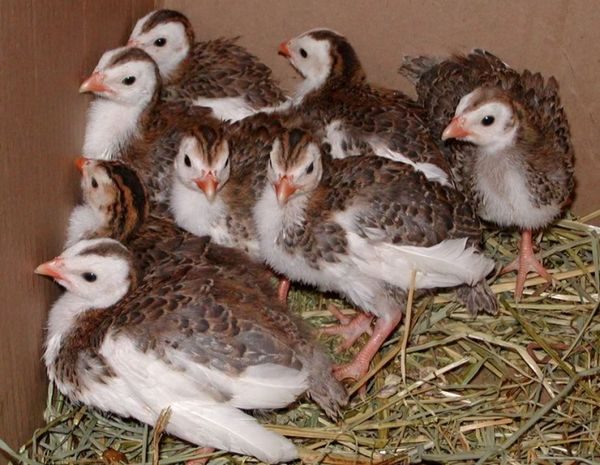
Diseases of chickens and adult birds
Guinea fowls are resistant and resistant to diseases of the birds, but despite this, they are still subject to certain diseases, arising mainly due to unsanitary conditions.
- Trichomoniasis. Diseases are susceptible to young individuals who consume dirty feed or water contaminated with trichomonas.In this disease, guinea fowls develop frothy yellow diarrhea, the birds lose their appetite and drink a lot of water, move a little and lower their wings. Appears mucous plaque on the throat and goiter, which complicates the process of breathing and eating food. For treatment, the drug ipronidazole and cardinosol are used, as well as antihelminthic therapy of all birds is performed.
- Pasteurellosis. The disease occurs when infected with young pasteurella. Symptoms: lethargy, inactivity, high hyperthermia, yellow droppings, gray or green with blood, discharge of mucous fluid from the nose. The infected bird is destroyed.
- Pullorosis. The bird almost stops moving, poor coordination is observed, the stool is white or yellowish. Affected guinea fowls are culled, and the whole herd is soldered with penicillin or biomycin.
- Mycoplasmosis. The bird breathes heavily, sneezes, and over time, wheezing appears, fluid is released from the nose, eyes turn red, and there may be a disorder of the gastrointestinal tract. For treatment used streptomycin and biomitsin. As a disease prophylaxis, young animals are soldered by Baytril or Enroksil.
Advantages and disadvantages of guinea fowls
Advantages:
- Strong immunity. Immunity to diseases.
- Good ones adaptive abilities.
- Endure very low and high temperatures.
- Simplicity in feeding.
- Feel great on walking
- High meat quality. Useful eggs.
- Feathers guinea fowls are in great demand.
Disadvantages:
- Noisy.
- Shy, and this negatively affects the incubation of chicks, therefore, it is better to use an incubator for breeding.
- On productive and life processes heavily influenced by lighting.
Conclusion
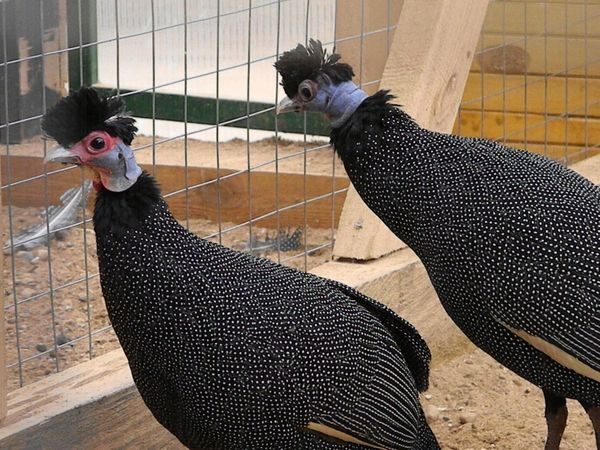
Guinea fowl are unpretentious and very beautiful birds that are used for both agricultural and decorative needs. Meat and egg products are distinguished by their nutritional value and usefulness.
Reviews
Guinea fowls are wonderful birds not only externally, but also for their productive qualities. The bird looks so decorative that it seems that it is bred not for meat, but for the soul. To get offspring must use an incubatorBecause hens are shy and often leave their nests unattended.
The bird grows quickly, 4 months and can be cut.
Eggs are better than chicken and do not provoke allergies, they can be safely given to children and are not afraid of consequences. It is true that guinea fowls replace the dog, as soon as a stranger enters the courtyard, then the noise rises to the whole district.
The bird helps to fight pests, they eat all the bugs and other parasites.
For the maintenance does not need a capital, insulated barn in the winter, guinea fowls feel normal in winter, they have to be heated only with very cold weather.
I used to think that guinea fowls are decorative birds, not agricultural ones, but as it turned out, I was greatly mistaken. The perfect meat, a bit like game and nutritious eggs, was enjoyed by my whole family. I have been breeding these birds for the second year now and I am very pleased.
Eat a little and grow fast. During the summer I grow young for meat, and for the winter I leave only the parent flock to continue the race. Yes, they are noisy, but it does not interfere at all with their content, I would even say the opposite, that it helps. If a bird starts screaming, it means something is wrong. In comfortable conditions and without external stimuli, the guinea fowl behaves calmly and quietly.
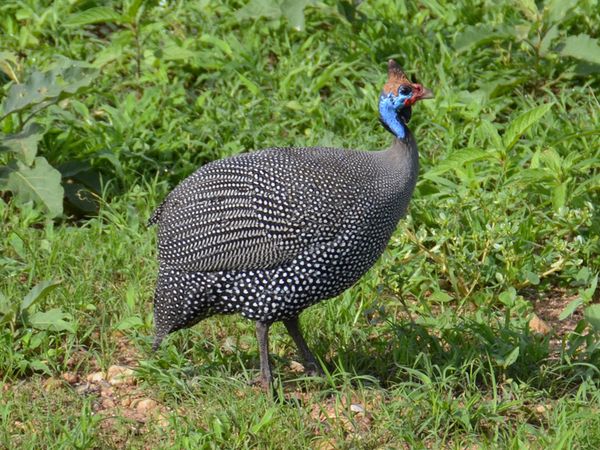
A neighbor began a year ago to breed gray-speckled guinea fowl. He treated eggs. I personally did not like the taste - I prefer the usual ones, but now my wife and daughter prefer these eggs. We have to buy from a neighbor. I read on your site that the eggs are really very useful and very saturated with carotenoids, so now I have started to eat them myself. In general, I advise for baby food - children should like it. Meat guinea fowls still try, unfortunately it was not possible. But, since I want to try, I signed up for a queue for a neighbor for the first hammered guinea fowl.